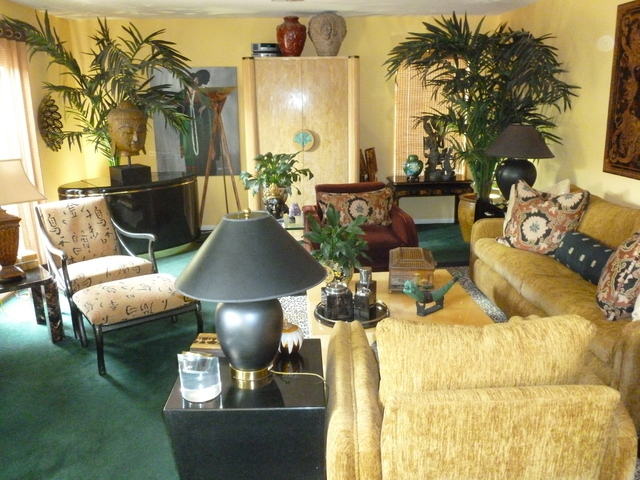Eclectic design characterized by freedom of expression
While asking new clients about their likes and dislikes, a husband and wife recently volunteered that their apartment back home was “eclectic,” or in their own words, “nothing goes with anything; they’re just pieces that we’ve accumulated over the years because we liked them.”
That was fine with me as I’ve always been a firm believer that clients have every right to furnish their homes as they see fit. After all, it’s their money and they’ll be living there long after my job as “the arbiter of good taste” is finished.
As a designer, I’m here to help them make informed decisions and as few mistakes as possible. And, hopefully, I help to give them the biggest bang for their buck — an admirable goal at any time, especially in today’s uncertain economy.
Soon after my meeting, I began to think about the real meaning of “eclectic” as it applies to furniture and interior design. Does it really mean putting together “anything and everything”? Or is it a term, like so many today, that has been misappropriated and can do with some updating and redefining. I think so.
It’s safe to say that basically, an eclectic style doesn’t rigidly adhere to one style but is rather a blend of furnishing styles from a mixture of sources and time periods. It’s characterized by a freedom of expression and great individuality, which my new clients seemed to readily exemplify. After all, the dictionary does define “eclectic” as “composed of elements drawn from various sources and then selecting what appears to be best in various doctrines, methods or styles.”
But in actuality “eclectic” goes well beyond that, because there are several basic fundamental principles that need to be adhered to — even with this kind of design — in order to achieve the best possible results. Eclectic really isn’t some kind of a jumble of whatever catches your eye. It will work to the greatest advantage only when the basic principles of design — namely line, color, texture, mass and form — are understood and work together to create a unified look.
Keeping these principles in mind, it’s still not a bad thing to begin with the premise that if you only buy what you love, somehow it will all work. And you know what, most times it does!
When combining different furniture, fabrics, finishes and objects from diverse periods and cultures, it’s still possible to create a room that is wonderful and unique to you alone and that will be admired by all who see it. In fact, it can probably be said that the more original your design, the better. Just don’t get so carried away with your own inventiveness that you create some kind of a hodgepodge or jumbled assortment of random items.
And remember that diverse styles can mix especially well when the background and furniture forms are kept simple and when the materials used have something in common, i.e., coordinating fabrics used on each piece.
In the example shown of the family room in my own home, the overall eclectic look comes largely from a mixture of my own contemporary furniture designs along with numerous Asian artifacts collected from trips over the years to China and Thailand. The tables and most seating incorporate clean lines and are a mixture of traditional, contemporary and Asian influences in its overall appearance.
There’s an Asian altar table, both contemporary and ethnic lamps, a sleek Italian goatskin coffee table sitting on top of a leopard-patterned area rug, wooden game chairs and several contemporary side tables in black granite and acrylic along with one imported from South America in black goatskin and horn. The use of several strong bold colors on the furniture along with the rough and unrefined natural brick of the fireplace mantel really does help to ground the palette as it contrasts with the golden tones on the seating and walls, but it still ties in beautifully, creating an interesting and comfortable space for relaxing.
This is but one example of the various styles that can make up an eclectic design. In a well-done room, you can see how good design works to make all the different styles work cohesively and not appear as if everything had just been thrown together.
If you want to have an eclectic room, try to choose one dominant look and then use a few pieces here and there from some other style. If you’re unsure as to the colors to be used, then try to lean toward neutrals that can go a long way in helping the different influences come together and work as a whole.
In a word, the philosophy behind eclecticism is to combine elements or particular styles from different time periods and different origins within a single room wherein all of the elements in that space are used thoughtfully and not chaotically. In the end, the whole design should appear as one piece of work brought together through the use of color, texture, shape and finish in a true “melting pot” of design elements.
I suppose that eclectic design is as popular as it is because it’s a great way to go if you can’t come to terms with choosing one style for your home. It allows you to forgo the “this has to match” mentality and experiment to create an interesting mix of furniture and accessories. But please remember that your goal is a controlled contrast of diverse elements.
And, by the way, my clients’ new home here will be pretty much contemporary-loft style — a change they’re sure to enjoy.
Stephen Leon is a licensed interior designer and president of Soleil Design (www.soleildezine.com); he has been designing and manufacturing custom furniture and cabinetry for more than 25 years. He is past president of the Central California/Nevada Chapter of the American Society of Interior Designers and is a certified professional in green residential design. Questions can be sent to soleildesign@cox.net.

















